How the Media Led the Great Racial Awakening
Years before Trump’s election the media dramatically increased coverage of racism and embraced new theories of racial consciousness that set the stage for the latest unrest
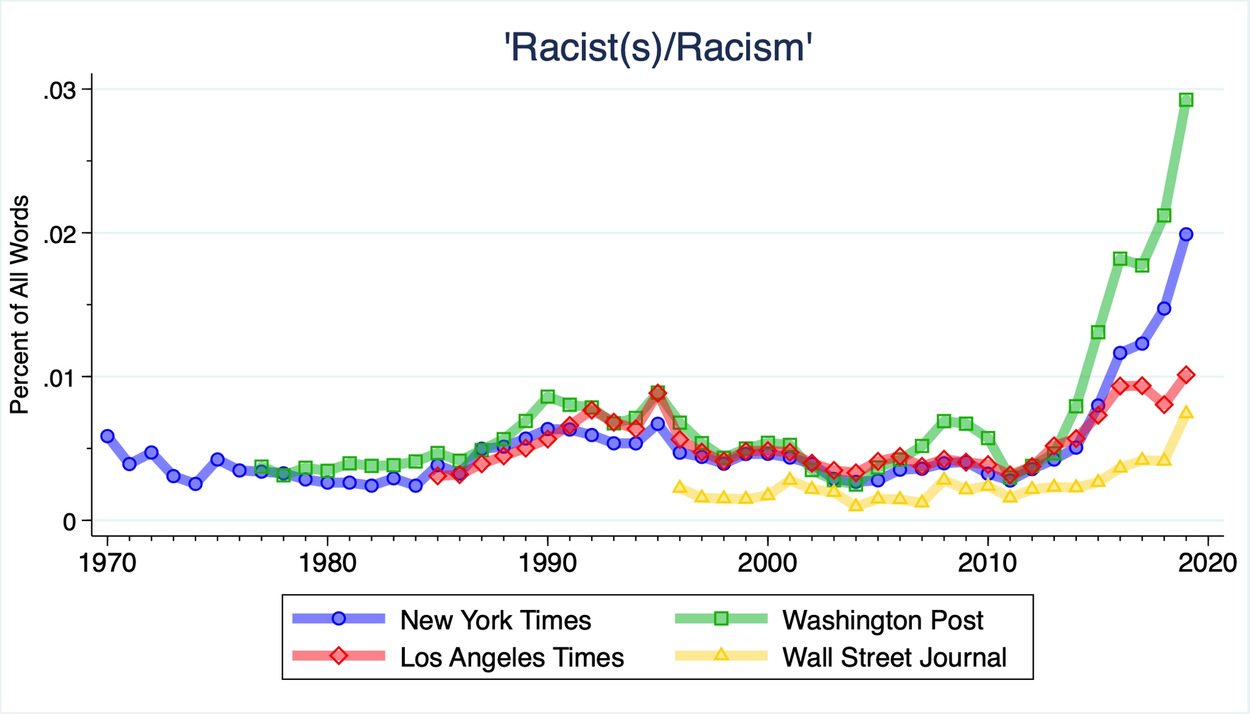
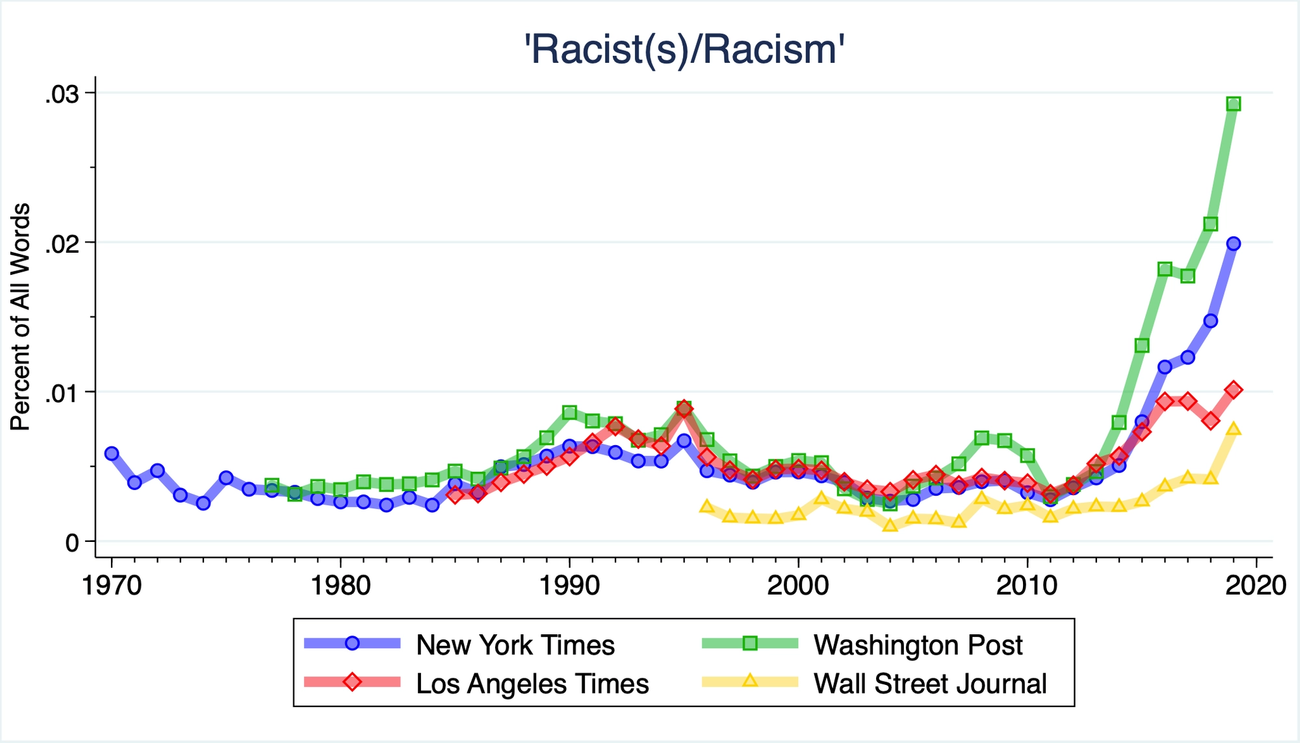


In the wake of the protests, riots, and general upheaval sparked by the police killing of George Floyd in Minneapolis, the United States is experiencing a racial reckoning. The response from America’s elite liberal institutions suggests that many have embraced the ideology of the protesters. Here, for instance, is a sampling of the titles of opinion pieces and news stories published over the past month by the country’s two most influential newspapers, The Washington Post and The New York Times:
The last entry on the list, a lengthy feature on America’s “caste system” in The New York Times Magazine, explicitly compares the United States to Nazi Germany.
Countless articles have been published in recent weeks, often under the guise of straight news reporting, in which journalists take for granted the legitimacy of novel theories about race and identity. Such articles illustrate a prevailing new political morality on questions of race and justice that has taken power at the Times and Post—a worldview sometimes abbreviated as “wokeness” that combines the sensibilities of highly educated and hyperliberal white professionals with elements of Black nationalism and academic critical race theory. But the media’s embrace of “wokeness” did not begin in response to the death of George Floyd. This racial ideology first began to take hold at leading liberal media institutions years before the arrival of Donald Trump and, in fact, heavily influenced the journalistic response to the protest movements of recent years and their critique of American society.
Starting well before Donald Trump’s rise to power, while President Obama was still in office, terms like “microaggression” and “white privilege” were picked up by liberal journalists. These terms went from being obscure fragments of academic jargon to commonplace journalistic language in only a few years—a process that I document here in detail. During this same period, while exotic new phrases were entering the discourse, universally recognizable words like “racism” were being radically redefined. Along with the new language came ideas and beliefs animating a new moral-political framework to apply to public life and American society.
Consider the graph below, which displays the usage of the terms “racist(s)” and “racism” as a percentage of all words in four of the nation’s largest newspapers from (depending on the publication) 1970 through 2019.

In 2011, the terms racist/racists/racism accounted for 0.0027% and 0.0029% of all words in The New York Times and The Washington Post, respectively. What we see over the past decade is a continual dramatic increase in usages of “racism” and its variations. Moreover, the graph shows that this increase occurred a half decade before the arrival of Donald Trump. By 2019, they would constitute 0.02% and just under 0.03% of all words published in the Times and Post—an increase of over 700% and just under 1,000%, respectively, from 2011. While increases in usage frequency are also observed for the more center-right Wall Street Journal, they are comparatively more gradual and modest. Notably, the shifts in the Times and Post trends precede those of the Journal by about a year, suggesting that the center-right Journal appears to react to the rhetorical and ideological trends on race advanced by the two biggest left-leaning newspapers. Over the period in question, starting in the mid ’90s, the Times and Post had always featured these terms more frequently than the Journal but, until recently, the difference was minor. Today, the gap is enormous, which suggests that the explosion in the usage of racialized terminology and ideological constructs isn’t simply a neutral reflection of an increase in racial incidents.
In 2016, The New York Times published a news article detailing efforts on college campuses to train new students on how to avoid and deal with microaggressions—one of the novel categories of racism popularized over the past decade that has contributed to the perception of pervasive racial injustice. As an example of a microaggression, the article cites the following comment: “Everyone can succeed in this society if they work hard enough.” This is supposedly racist because it emphasizes individual agency and implies “that race plays a minor role in life’s outcomes.” In the absence of legal discrimination, in the post-affirmative-action era, and in light of the immense absolute improvements in the quality of life of the average Black person over the past half century, concepts like “microaggression” and “implicit bias” have been critical in cultivating the perception, amplified by the media, that America still practices a form of insidious racial apartheid. This occurs by a process of concept creep—a stretching of the terminological and normative boundaries of what constitutes racism and racist behavior. In other words: The racialization of things that weren’t previously viewed or understood through the lens of race. The upshot is that the more aspects of social life the media racializes, the more “racism” there is for the media to report on.
In 2011, just 35% of white liberals thought racism in the United States was “a big problem,” according to national polling. By 2015, this figure had ballooned to 61% and further still to 77% in 2017.
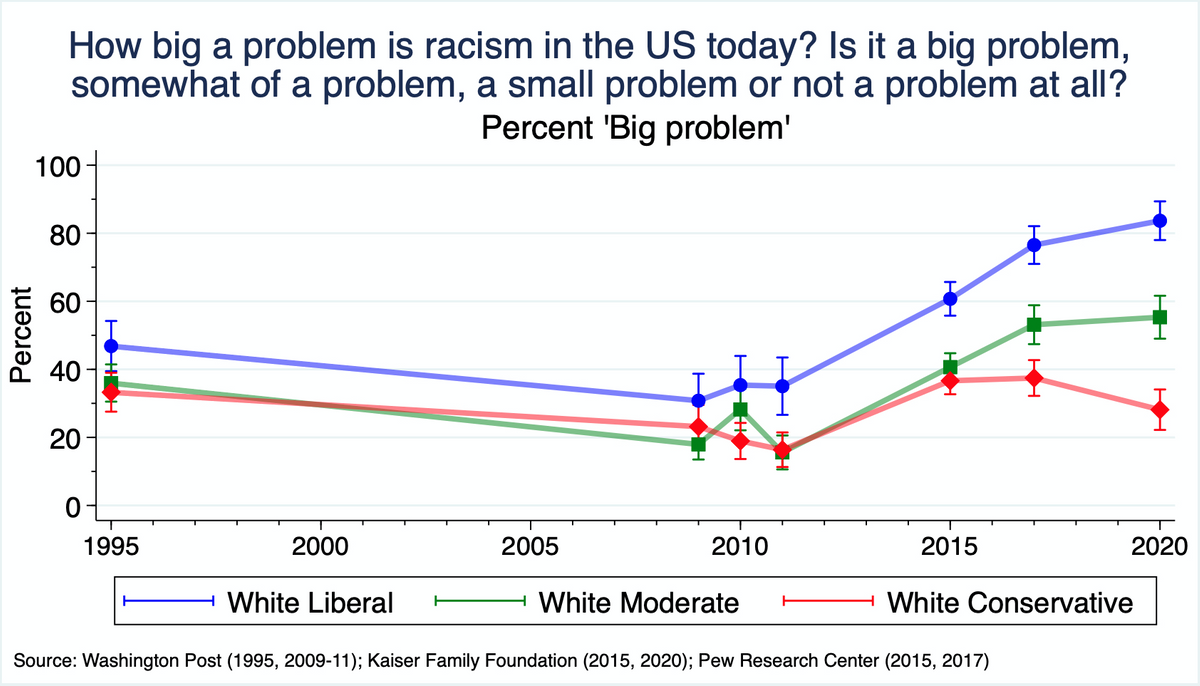
In December of 2006, 45% of white Democrats and 41% of white Republicans reported that they knew someone they considered racist. By June of 2015, this figure increased to 64% among white Democrats, while remaining at a steady 41% among white Republicans. No increases were observed for any of the nonwhite Democrat groups. In fact, what (statistically insignificant) change occurred among Black (52.7% to 47.2%) and Hispanic (41.1% to 33.8%) Democrats were actually in the opposite direction.
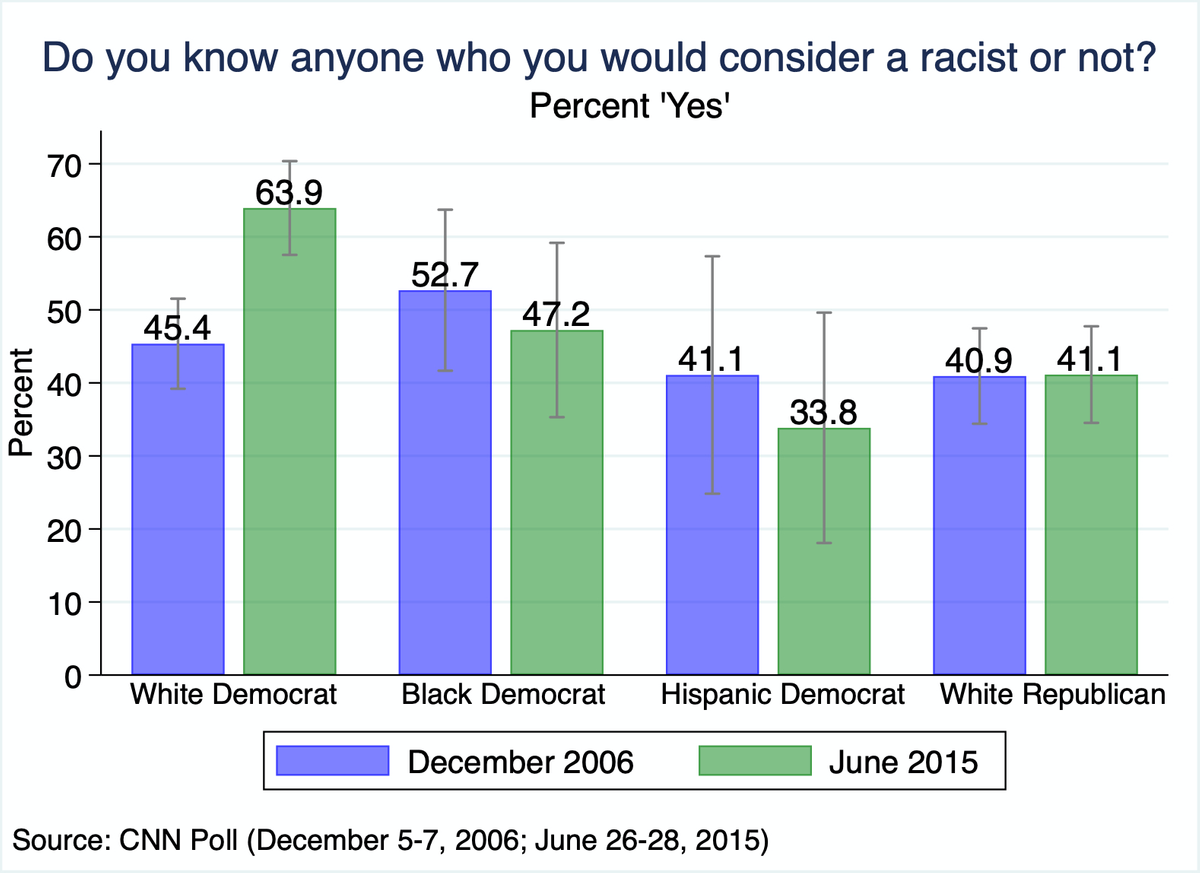
Did white Democrats simply come to know more racists in these years? It’s possible, but if so that would indicate that the media’s increased reporting on racism actually correlated to a marked increase in racists being detected by white Democrats. It was during this same period, as I documented in a previous article, when the racial attitudes of white liberals became radically more liberal, relative to changes observed among nonwhite Democrats and white conservatives. For example, data from the General Social Survey shows that beginning in 2010, the percentage of white liberals who disagreed with the statement: “Blacks should work their way up without special favors,” has grown in almost every subsequent year the question was asked. Starting in 2010, when 24% of white liberals (21% of white Democrats) said they disagreed with the statement, the number rose to 30% (23%) in 2012, then 36% (26%) in 2014, and finally to 52% (39%) in 2016. It sits at around 50% as of 2018. Between 1994 and 2012, there was never a year in which more white liberals or Democrats gave this response than their nonwhite counterparts. By 2016, however, a divide that started appearing in the preceding few years came into full relief—that year, 29% of nonwhite liberals (28% of nonwhite Democrats) and 38% of Black liberals(34% of Black Democrats), disagreed that “Blacks should work their way up without special favors.” In other words, by 2016, white liberals were almost 80% more likely to give this response than nonwhite liberals, and almost 40% more likely than Black liberals.
One possible way of explaining these statistics, is that America experienced an explosion of racism over the past decade and white liberals are uniquely reflective of that change. But another possibility, perhaps more likely, is that ascendant progressive notions about race reflected in a steady drumbeat of reporting and editorializing on the subject from leading national media outlets, encouraged white liberals to label a larger number of behaviors and people as racist. In other words, while the world may have stayed more or less the same, elite liberal media and its readership—especially its white liberal readership—underwent a profound change.
There is a body of social science research arguing that shifts in race-related media coverage have a causal effect on racial attitudes. For instance, political scientist Paul Kellstedt has provided evidence showing that shifts in racial attitudes follow shifts in race-related news content. But, while building on Kellstedt’s findings, my own research suggests that not all demographics are equally or even similarly responsive to such media trends. Specifically, I find that the causal effects of race-related media coverage are strongest for white Democrats and liberals, weaker for nonwhite Democrats and liberals, and are largely nonexistent for white Republicans and conservatives. This differential effect is partly due to ideological differences in understandings of racial inequality, which influences how white liberals and conservatives respond (particularly in the moral-emotional sense) to related information.
Like Kellstedt, I compiled dozens of time series of racial attitudes—ranging from perceptions of discrimination and attributions of racial inequality to race-conscious policy attitudes—and ran them through an algorithm that was originally developed by James Stimson to generate singular aggregate indexes of general public policy liberalism. I then added the resulting “racial liberalism” index to my dataset of media term-usage, which provides the basis for the analysis in this article. While many of the terms were strongly correlated with the racial liberalism index, subsequent analysis showed that the latter was most uniquely associated with a scale (which I labeled the “Woke Term-Usage Index”) generated from the usage frequency of terms like, “privileged,” “systemic racism,” and “racial disparities,” in The New York Times.
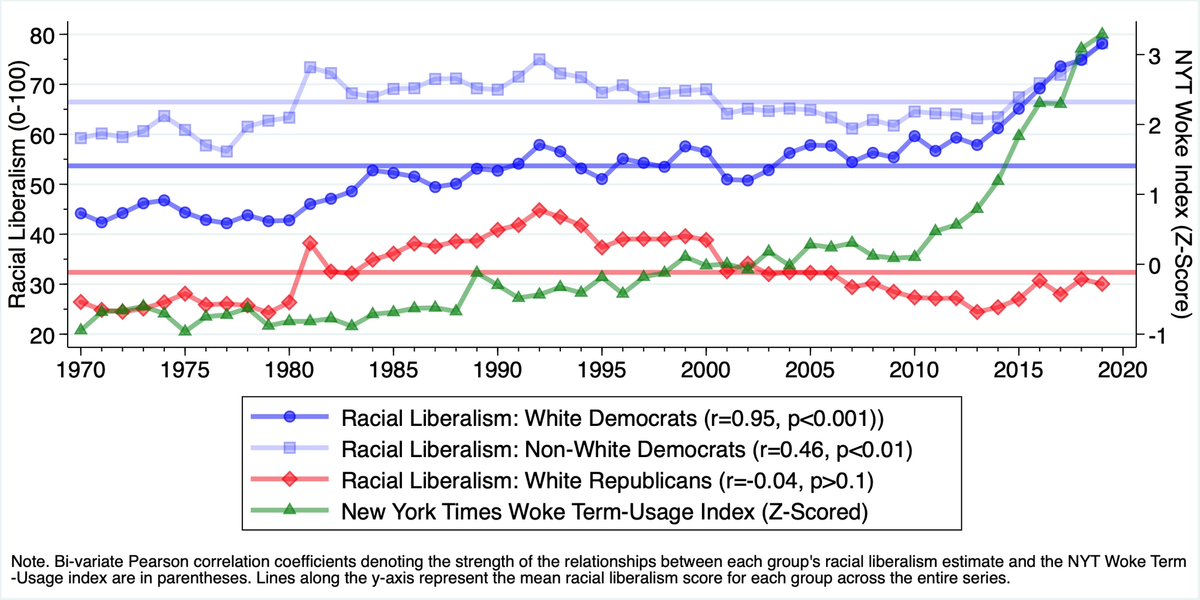
In the graph above, we see that shifts in the Times’ usage of woke-related terminology (green line) almost perfectly coincides (r=0.95) with shifts in racial liberalism (darker blue line) among white Democrats (and among white liberals as well). The same relationship is significant but much weaker for nonwhite Democrats (light blue line), and both insignificant and negligible for white Republicans (red line). The visible trends along the y-axis underscore how much racial attitudes have moved for each subgroup. For instance, across all years (1970-2019), white Democrats averaged a racial liberalism score of 54—just above the midpoint of the scale. In 2019, however, the score of the average white Democrat sat at 78—almost three standard deviations above their mean for the entire series. While nonwhite Democrats have also become more racially liberal, their 2019 score (also 78) is just 12 points above their series mean (66). In contrast, the average white Republican in 2019 scores 30.1, only around 2 points away from the white Republican series mean (32.4).
These relationships, in and of themselves, don’t necessarily prove anything. Based on this data alone, it could be the case, for instance, that racial liberalism drives shifts in media coverage as opposed to the reverse. However, further analysis shows that woke-related term-usage significantly predicts subsequent racial liberalism while racial liberalism does not significantly predict subsequent term-usage. Additionally, term-usage remains a strong and significantly positive predictor of Democrats’ and liberals’ racial liberalism across variables like consumer sentiment, general policy liberalism, and generational replacement.
Yet, even these findings, while suggestive, don’t prove that the media coverage at leading liberal outlets like The New York Times and Washington Post is causing shifts in racial attitudes. What it shows dispositively is that the newspapers covered here are both talking about racial inequality and race-related issues far more frequently than they have since at least 1970 as well as increasingly framing those issues using the terms and jargon associated with “wokeness.” Additionally, it shows that the racial liberalism of white liberals has closely followed these trends in media coverage, rather than preceding them.
It is beyond the scope of this article to fully explain the underlying causes of these changes but it should be noted that even the most powerful traditional media outlets—whether that’s The New York Times or cable news—exist within a larger ecosystem that is increasingly shaped by digital actors. The agenda-setting and issue-framing powers that social media platforms like Twitter have provided to progressive activists appears to be a central driver of both the shifts in white liberals’ racial attitudes and the transformations within traditional media. Even the most powerful and storied names in newspaper publishing are increasingly responsive to and influenced by political sentiments percolating on social media, where all manner of racialist ideology thrives.
The idea of “concept creep” originates with Nick Haslam, a professor of psychology at the University of Melbourne, Australia. In a research paper published in 2016, “Concept creep: Psychology’s expanding concepts of harm and pathology,” Haslam posits that: “Concepts that refer to the negative aspects of human experience and behavior have expanded their meanings so that they now encompass a much broader range of phenomena.” This expansion, according to Haslam, “primarily reflects an ever-increasing sensitivity to harm, reflecting a liberal moral agenda.”
One of the primary drivers behind the conceptual creep around racism is the idea that all observed disparities between different groups in a society are a product of bias. This view as well as its policy implications for any institution that takes it seriously are captured succinctly by one of the most influential voices in the racial consciousness industry, Atlantic magazine writer and author Ibram X. Kendi. In a line from his book Stamped from the Beginning, Kendi writes: “We have a hard time recognizing that racial discrimination is the sole cause of racial disparities in this country and in the world at large … When you truly believe that racial groups are equal, then you also believe that racial disparities must be the result of racial discrimination.” Kendi is saying that any evidence of uneven outcomes between groups—for example, Black people being underrepresented in a particular profession relative to other groups and their share of the overall population—is necessarily evidence of racism that should be remedied by discriminating against the non-Black groups. Yet this reasoning is intuitively appealing only when (in addition to ignoring the various nonwhite groups that outperform whites) it utilizes the very same racial categories that those like Kendi rightfully criticize for being arbitrarily or socially constructed (if statistically and politically convenient).
When one disaggregates “whites” into different ancestral groups, the disparities between many of them are unmistakable. For instance, and for what is likely a host of different reasons, there is a great deal of between-group variance in higher-degree attainment among American-born whites of single European ancestry. According to data from the 2017 American Community Survey, roughly 50% of those reporting single Russian ancestry have bachelor’s degrees or more, while this is true of only 27% of those of French and 18% of those of Portuguese ancestry, respectively. To put this into perspective, these gaps are double and nearly triple the size, respectively, of the degree-attainment gap between aggregate Blacks (16.2%) and whites (27.2%). Would Kendi insist that this, too, is dispositive proof of discrimination?
The truth is that unless or until one is able to determine the “baseline disparities” between populations—i.e., disparities that would obtain even in the absence of racism and discrimination—there is no way to quantify or determine with certainty the extent that disparities can be attributed to discrimination and bias. In certain domains, there may appear to be a fairly straightforward correlation between historical racism—for example in biased hiring practices—and unequal outcomes. But in other fields the connections will not be as clear and disparities may be better explained by other variables, such as cultural customs and preferences. In either case, it would be impossible to know for sure which was the cause. Nevertheless, the new doctrines of anti-racism insist that any differences in group outcomes must be attributable to racist social structures and institutional biases—any other account of disparities in outcome would be tantamount to “blaming the victim.” Though the academic theories advancing this idea are decades-old, they only became the conventional wisdom at major newspapers over the past decade, as mentions of racial inequalities multiplied. For instance, as the graph below illustrates, from 1970 until 2014, the combined usage frequency of the three “macro-level” racism terms—systemic racism, structural racism, institutional racism—never exceeded 0.00006% of all words in any of the four newspapers. By 2014, however, this ceiling was shattered, particularly in the Times and Post. In the final year of the series (2019), the Times (0.0004% of all words) and Post (0.00056%) were using these terms roughly 10 times more frequently than they were in 2013 (0.00004%, 0.00005%).
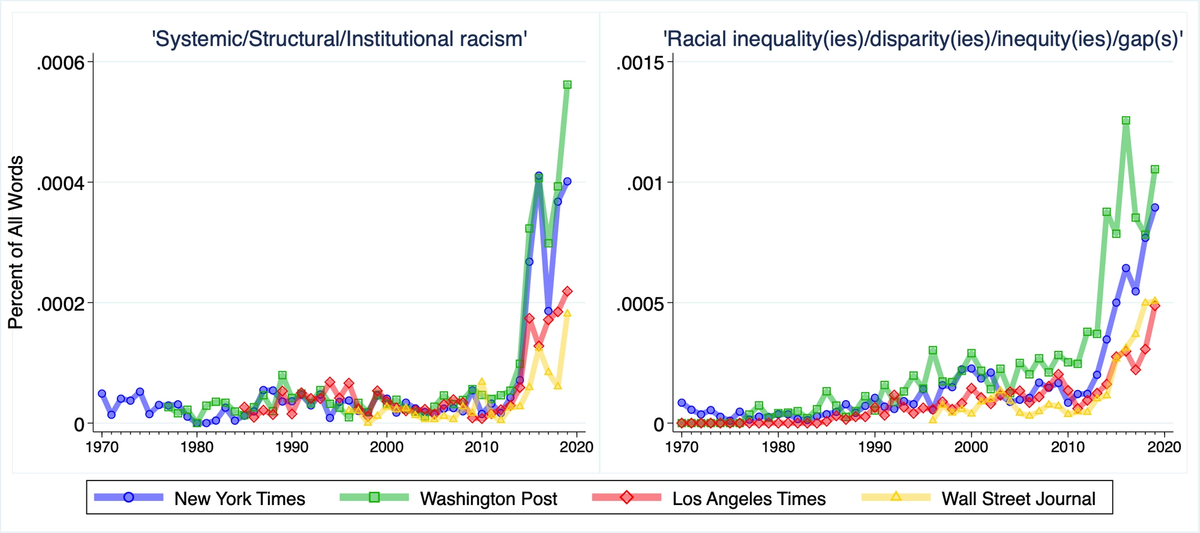
While the frequency of macro-level racism references and terms tied to inequality-related “disparities” (the figures represent the sum of the proportions of all listed terms: Racial inequality + Racial inequalities + Racial inequity + Racial inequities + Racial gap + Racial gaps) appear to move in unison, the data shows this to be a fairly recent correspondence. Prior to 2014, there was only somewhere between a weak relationship to none at all between the two sets of terms. From 2014 and onward, though, movement in frequency of the inequality-related terms is consistently attended (at least in the Times and Post) by similar movement in the frequency of macro-level racism. In other words, the data suggests not only that more attention has been given to racial disparities, but also that racial disparities themselves are increasingly framed in terms of systemic racism theory. Although this frame is now commonplace, it wasn’t so until just a few years ago.
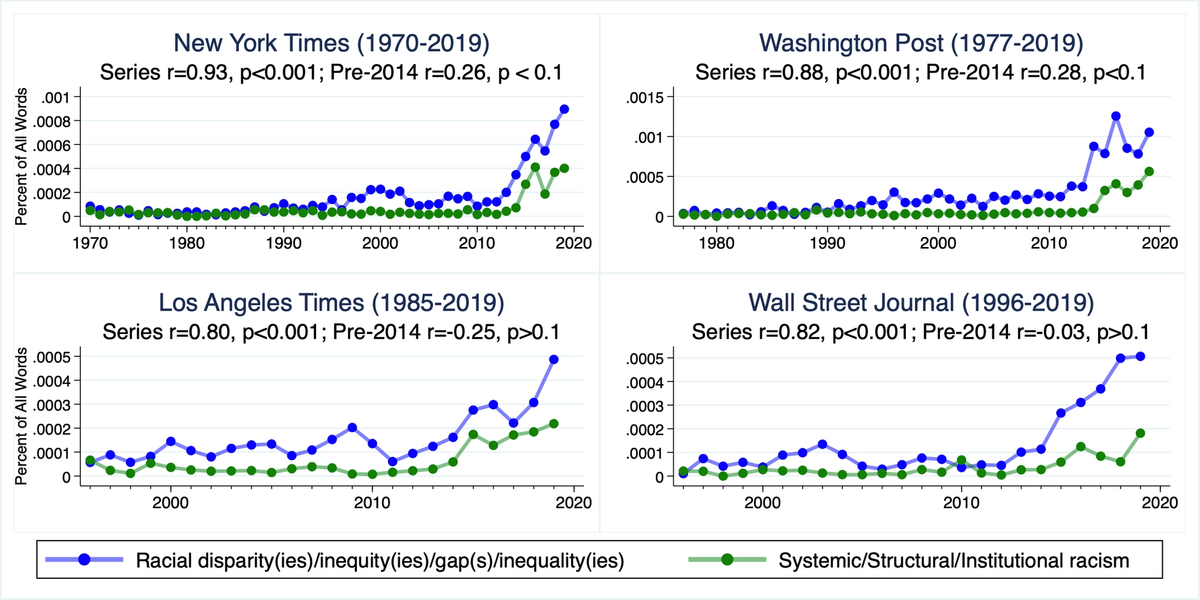
A deeper textual analysis of the Times data lends additional support for the connection between references to racial disparities and theories of systemic racism and “white supremacy.” The degree or frequency at which the two terms appear in the same body of text (which, in technical jargon, can be referred to as “latent association”) climbed to a record high in the second half of the past decade. This means that Times articles that include these disparity-related terms are now more likely than ever to also feature those referring to macro-level racism.
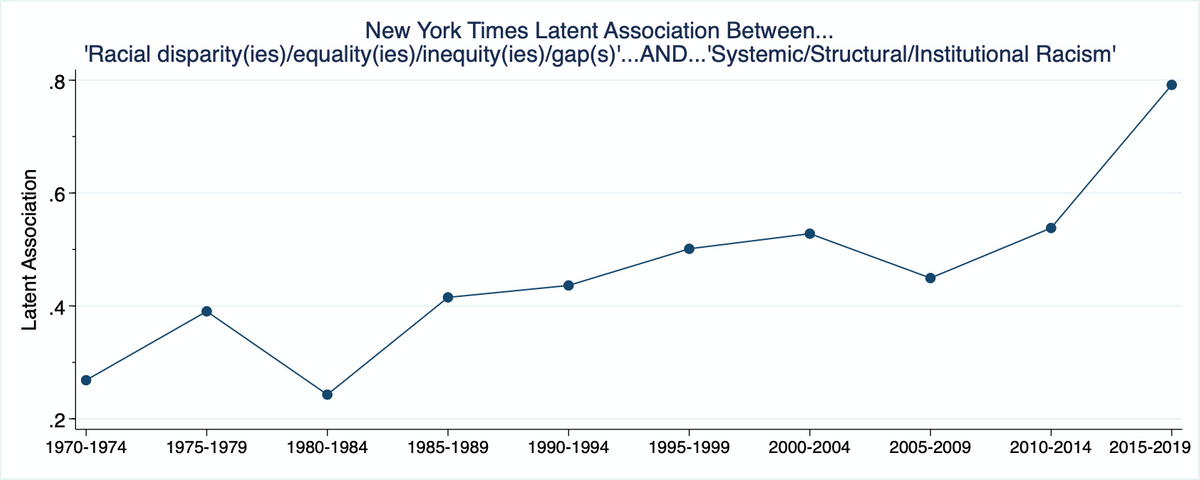
Research shows that how members of advantaged or “privileged” social groups react to group inequality is informed by his/her views of its legitimacy. Those who are inclined or habituated to see it as illegitimate (such as white liberals) are likely to experience feelings of shame, guilt, and/or in-group-directed anger. These aversive feelings, in turn, correspond to needs for moral acceptance and validation vis-à-vis members of disadvantaged out-groups. These needs then motivate the adoption of pro-out-group (or “woke”) attitudes and behaviors that both signal one’s moral solidarity with the unjustly disadvantaged out-group while also distinguishing oneself from the undeservingly privileged in-group. In the other direction, group members that don’t perceive that such inequalities are entirely or at all illegitimate are likely to resent being unjustly blamed for them and to consider the maligning of their moral status unfair.
The divergent moral reactions toward perceived inequities have not emerged in a vacuum. Rather, the informational or media environment interacts with underlying orientations to elicit them. Members of society can be encouraged to see themselves and others as belonging to homogenous in-groups and out-groups. They can, further, be made aware, through frequent reminders and exposure, of the outcome disparities between them and the pervasiveness of discrimination. Finally, these inequalities must be framed as illegitimate and resulting from the past and/or present injustices perpetrated by the advantaged against the disadvantaged. Taken together, and in the context of the “Great Awokening,” white people need to see themselves as belonging to a collective that enjoys illegitimate privileges at the expense of racial others. Similarly, nonwhites need to be frequently reminded of their victimhood and unjust social position. They see themselves as belonging to a collective that is bound by their experience of racial oppression. The effect overall in terms of the coverage at publications like the Times and Post is that quite often, articles about racism are not reports about events occurring in a particular time and place—they are part of a totalizing theory of the world.
As the graph below illustrates, the greater the mentions of “racism” and “racist(s)” in newspaper accounts, the greater the mentions of “white people.” Though the correlation between the two terms are strong across all four newspapers, it is near perfect (i.e., r=1) for the left-leaning New York Times, and weakest for the center-right Wall Street Journal. Of course, this association—white people and racism/racist(s)—is both predictable and sensible given American history. One might conclude, then, that as the media devotes more coverage to racism and race-related issues, it is inevitable that white people would be mentioned more as well since, as a group, they are implicated in these discussions.
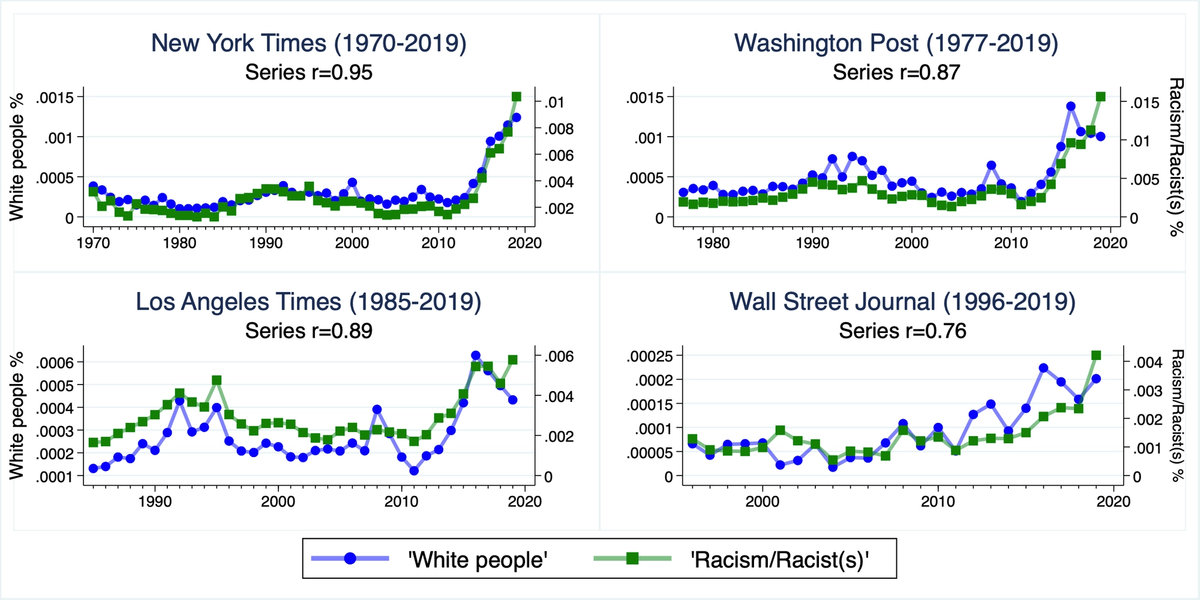
And yet, it is not simply the case that most discussions of racism contain some reference to white people. In fact, when terms for Blacks/African American(s), Hispanics/Latinos, and Asian/Asian(s) are entered together or separately into a model for each of the four newspapers, “white people” emerges as the strongest positive predictor of “racism/racist(s)” usage. Further, it’s not just that these terms are being used more frequently independent of each other. As the graph of their latent association below suggests, the extent that they occupy the same lexical space has never been stronger than it has in the past few years.
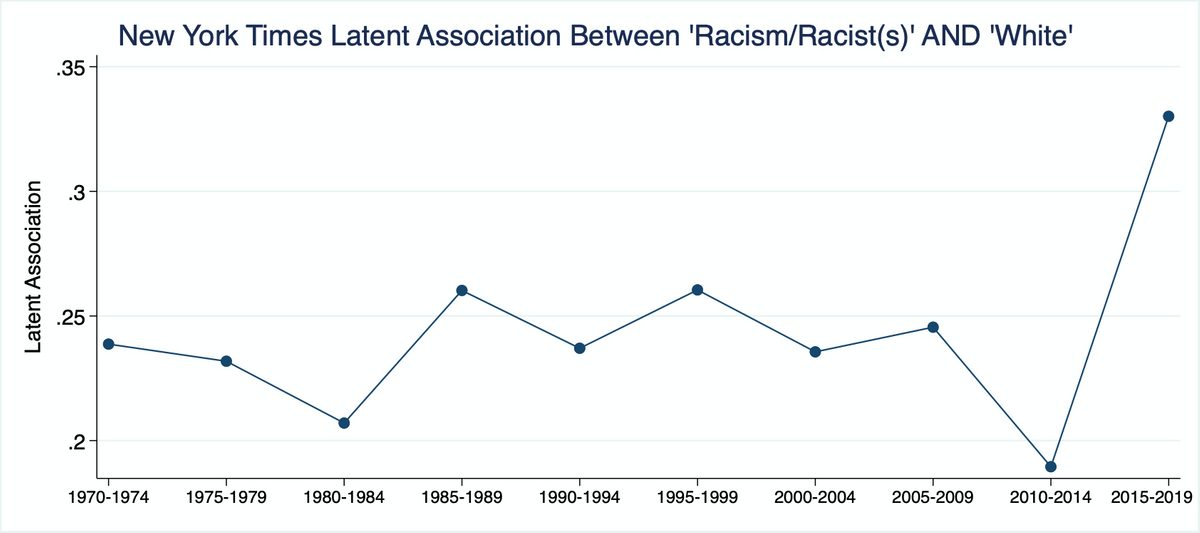
What the evidence suggests, is that leading publications have not only vastly expanded the definition of racism and actively promoted a more racialized view of American society—in a period beginning under a Black president and during which many indicators showed slow and frustrating, but consistent, racial progress—but have done so, in part, by normalizing and popularizing the notion of “white people’s” collective guilt. The latest offering from The New York Times’ popular podcast lineup, introduced just last week, is called “Nice White Parents” and perfectly illustrates the point. The Times’ description of the podcast, focused on why reform initiatives have failed to fix the problems in American public schools, suggests it has found the source of the problem: “Arguably the most powerful force in our schools: White parents.”
Until just a few years ago, such reductive and Manichaean racial narratives were largely confined to overtly white nationalist and Black nationalist groups and the pages of little-read academic critical theory and sociology journals. But as the graph below reveals, this once-rare framework has been incorporated into the lexicon of mainstream, particularly left-leaning, newspapers.
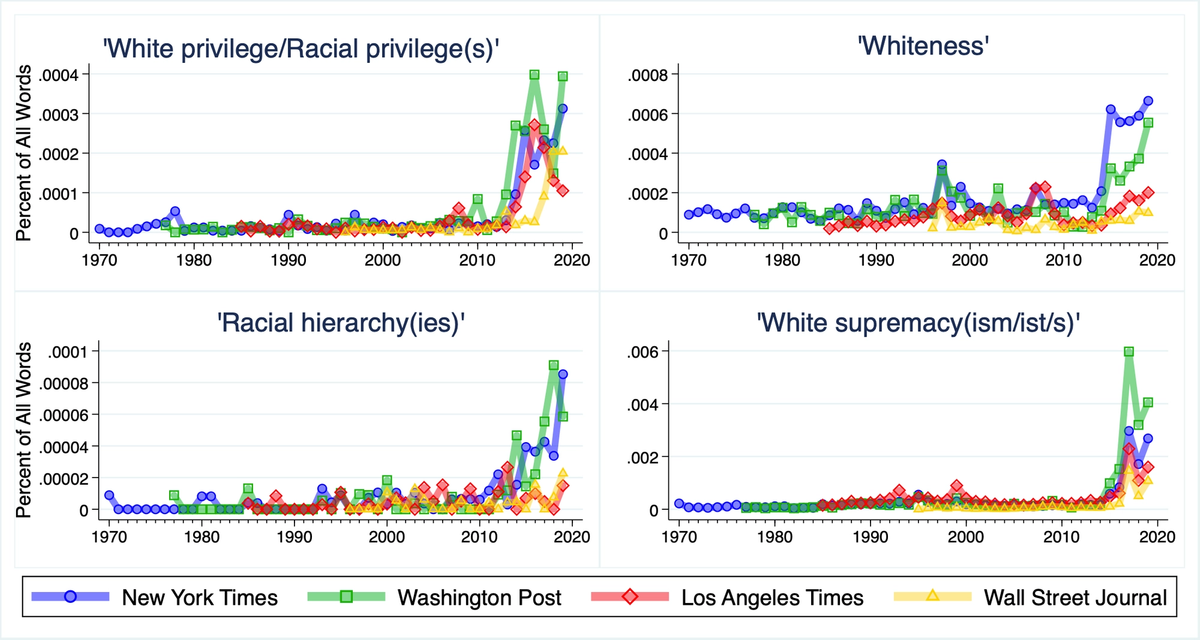
Prior to 2013, the terms “white” and “racial privilege(s)” appeared in an average of 0.000013% and 0.000015% of all words in the Times and Post, respectively. Between 2013 and 2019, these average frequencies grew by an astounding 1,200% in the Times, which was surpassed by nearly 1,500% increase at the Post. Meanwhile, the frequency at which “privilege” shared the same lexical space as terms like “white,” “color,” and “skin” reached a record high.
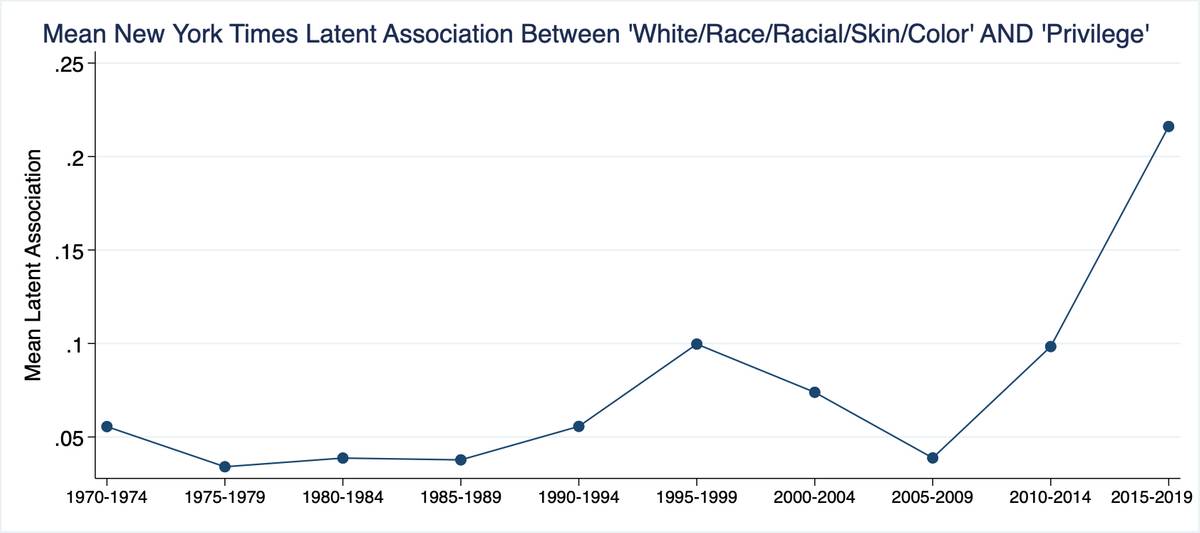
The spike in the usage of “whiteness” was similarly sudden, if comparatively modest. Until 2015, the term averaged a usage rate of approximately 0.0001% of all words in the Times and Post, respectively. Since 2015, however, it’s frequency has ranged from 0.0005% to nearly 0.0007% of all Times words, and from 0.00032% to 0.00055% of all words in the Post—that is an average yearly increase of roughly 500% and 360% respectively, in the two leading national papers.
The spikes for “white supremacy” and variant terms are remarkable given that they are by no means novel and so started from a higher baseline. Until a few years ago, their usage was likely limited to references to actual card-carrying white supremacists. But as with “racism,” these terms have since been radically expanded by a rapid and ideologically driven concept creep. White supremacy is now a vague and all-encompassing label. Instead of describing the demonstrably discriminatory ideas and actions of particular institutions or individuals, white supremacy is now understood by many progressives to be the fundamental ethos of the American system as a whole.
Whatever it used to mean, “white supremacy” is now everywhere and applicable to any context. Consider that until 2015, terms related to “white supremacy” almost never registered at more than 0.001% of all words in a given year in any of the above newspapers. With the exception of The Wall Street Journal, whose upswing was less consistent, this ceiling has been comfortably breached in every year since. By 2019, the Times and Post were respectively using these terms approximately 17 and 18 times more frequently than they were in 2014. Incidentally, white liberal readership of the Times and Post saw marked growth across this same period. In 2014, the Pew American Trends Panel survey asked panelists to indicate the sources they received political news from over the previous week. As is shown in the graph below, 27% and 10% of white liberals reported getting news from the Times and Post, respectively. When this same question was asked five years later (2019), these figures had climbed to 46% and 36%.
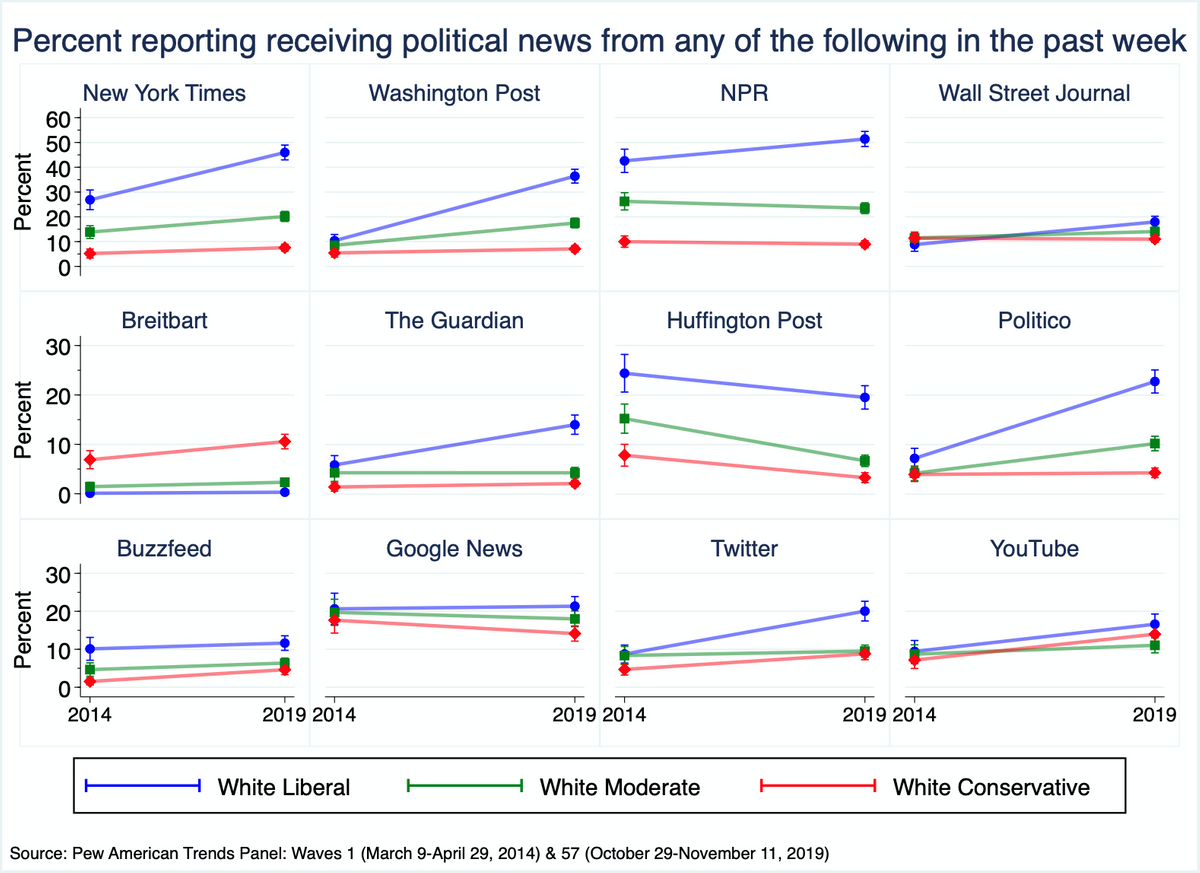
These increases accord with those observed in the American National Election Studies survey, where, in 2012, 19% and 6% of white liberals reported regularly getting news from the Times and Post, respectively, as compared to 34% and 24% in 2016. And to the extent that these and other publications have gone increasingly and largely “digital” in recent years, they are also consistent with the significant growth in the percentage of white liberals (from 36% in 2014 to 55% in 2019) who list the internet and/or social media as their primary news medium.
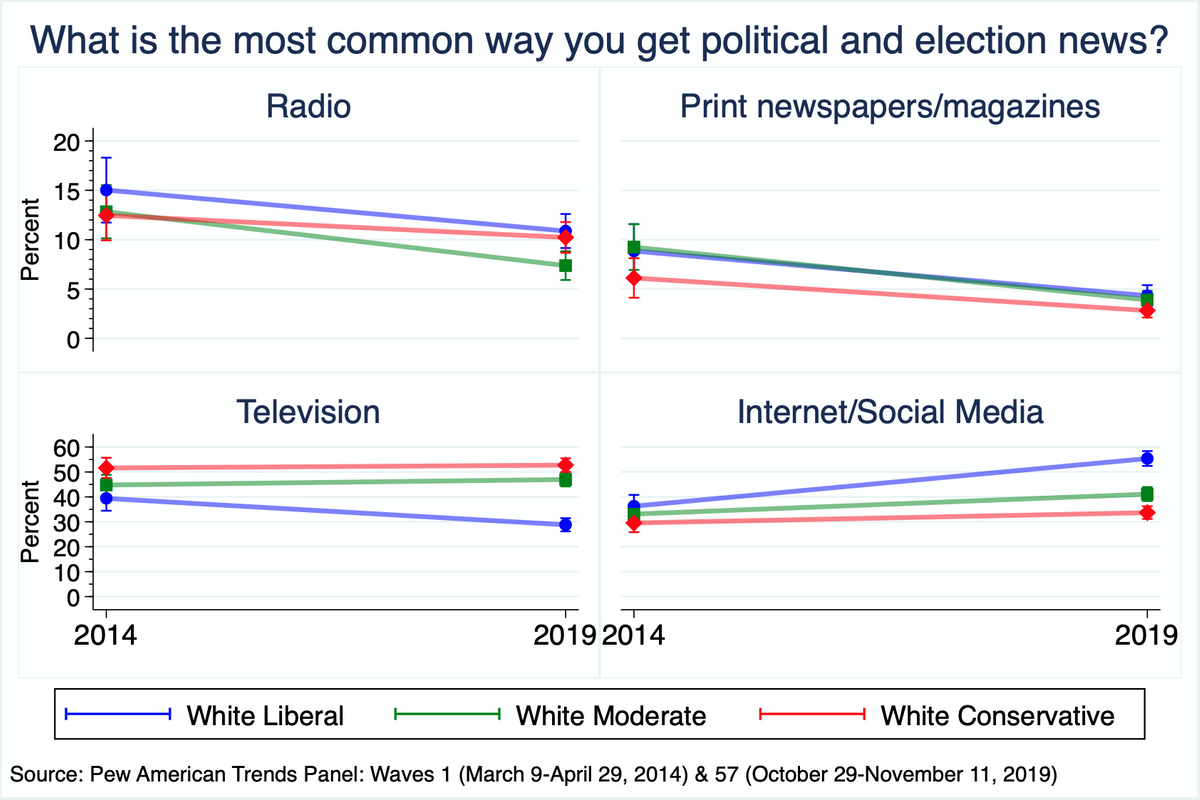
If white people have become increasingly associated with racism, unearned privilege, and white supremacy in the media, what of nonwhites? Well, first off, they are no longer “nonwhites”—they are “People of Color.” And because they are “People of Color,” they are necessarily “marginalized” and rendered “vulnerable” by the “whiteness” around them. Or at least this is how they are seemingly portrayed in today’s media environment. As is evident in the graph below, until very recently, usage of “of color” terms were rare across all of the four listed newspapers. For instance, until 2014, the highest usage frequency for these terms in The New York Times was 0.00017% (in 1992 and 2007, respectively). By 2014, this record was broken and replaced by one double in size (0.00035%). And every subsequent year has broken the record established in the previous. By 2019 (0.0027%), the Times was using “of color” terms 19 times more frequently than it was in 2013 (0.00014%).
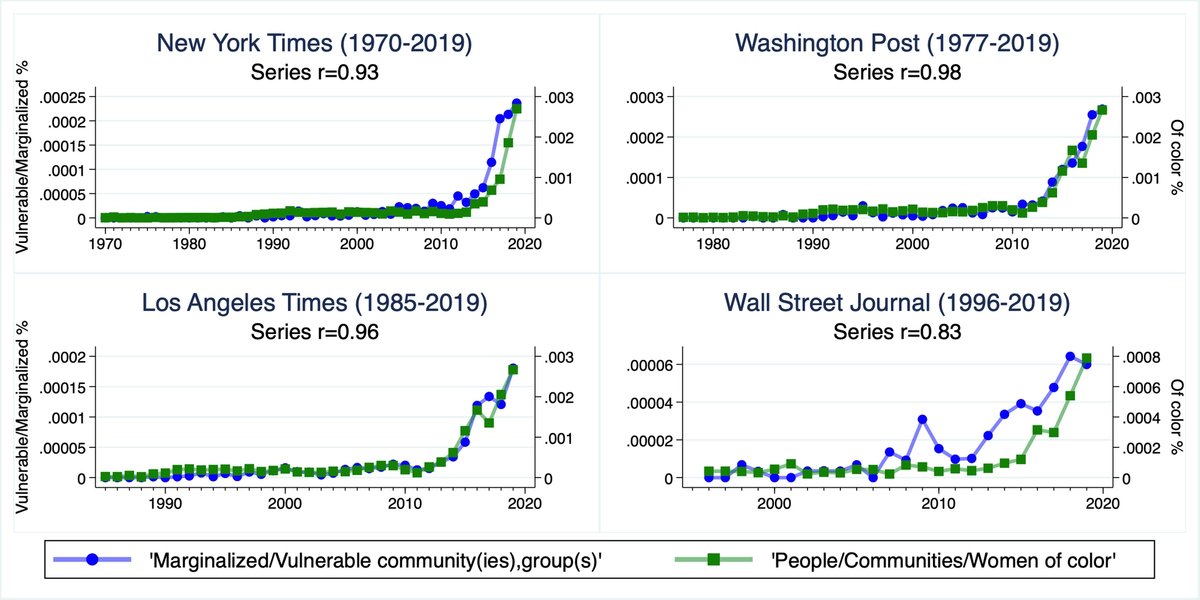
A very similar pattern is observed for the “marginalized/vulnerable” terms (note that I averaged these terms after finding them very strongly correlated). In fact, the data suggest that, for most of the listed newspapers, movement in the frequencies of these terms almost perfectly coincides with movement in that of the “of color” terms. Before 2014, the highest usage frequency for the “marginalized/vulnerable” terms in the Times was in 2009, when it came in at just under 0.00003% of all words. From 2014 (0.00005%) and onward, it has steadily increased. By 2019 (0.00023%), these terms were appearing over seven times more frequently than they were in 2013.
An analysis of latent associations in the Times (depicted below) shows that the word “color” increasingly appears together in a passage of text with words like “marginalized/marginalization,” “vulnerable,” and “oppressed/oppression.”
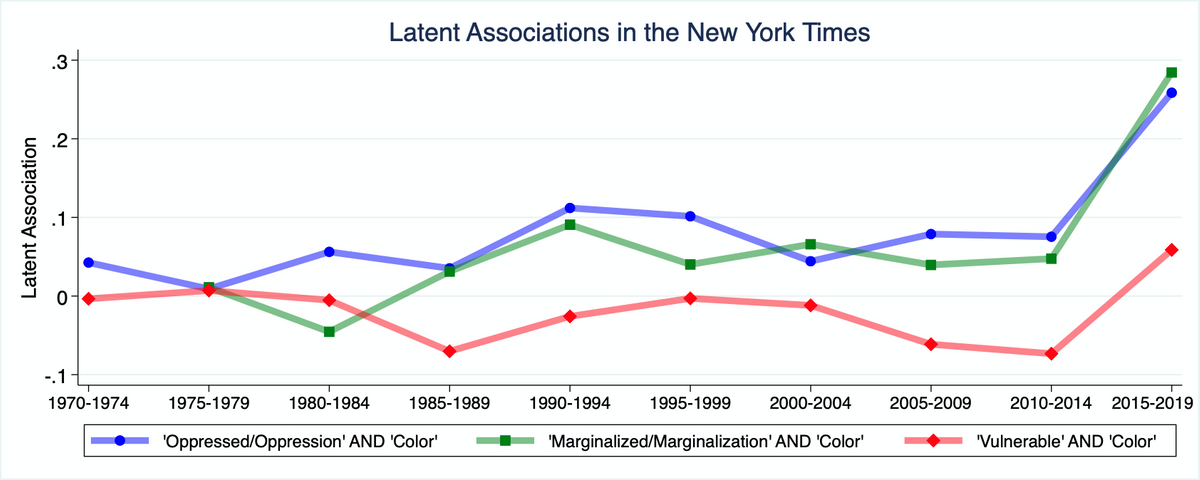
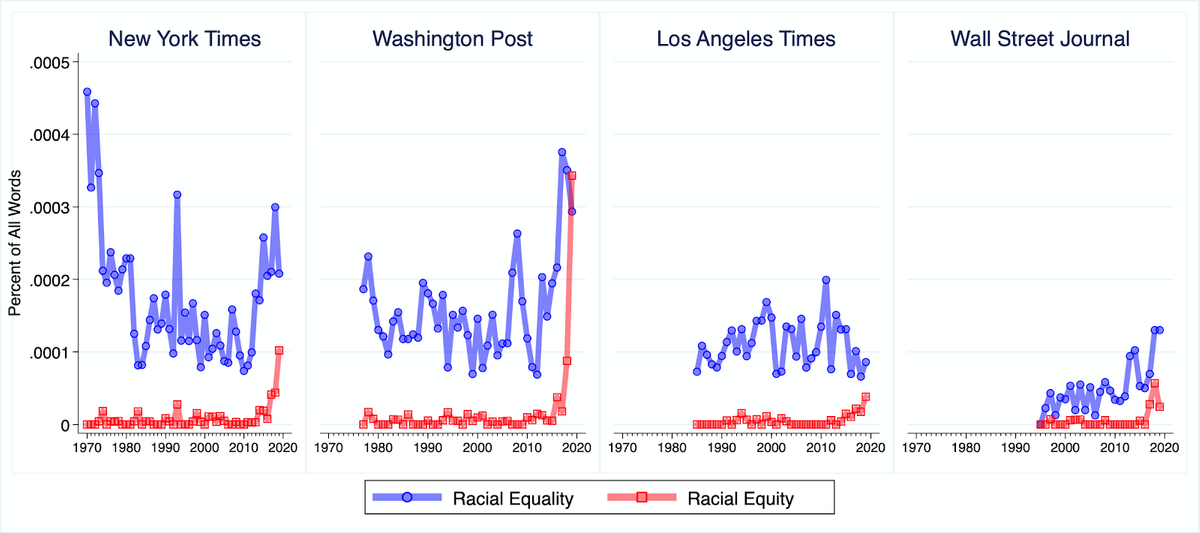
For decades, the term “racial equality” was the ubiquitous framework for understanding and evaluating racial justice. This is now changing as “equality” gives way to newer concepts such as “racial equity,” which refers to the redistribution of resources from the supposedly privileged to the supposedly disadvantaged as a means to redress claimed discrimination. As Ibram Kendi puts it: “If discrimination is creating equity, then it is antiracist. If discrimination is creating inequity, then it is racist ... The only remedy to racist discrimination is antiracist discrimination. The only remedy to past discrimination is present discrimination. The only remedy to present discrimination is future discrimination.” Thus the goal is no longer ‘racial equality’ or equal treatment under the law. It is, rather, the attainment of a state of the world in which all groups have equal outcomes—even if some are deliberately disadvantaged in the process. Until very recently, “racial equity” was a largely unfamiliar phrase only rarely featured in the pages of the major newspapers. But this has changed dramatically in the last few years. In 2013 “racial equity” constituted 0.000003% of all words in The New York Times. One year later, it was being used six times more frequently (0.00019%). And, by 2019, nearly 32 times more frequently (0.000096%). Remarkably, in The Washington Post, “racial equity” was not only being used 27 times more frequently in 2019 (0.00032%) than in 2013 (0.00012%), but it’s rate of usage actually surpassed that of “racial equality.”
It might be pointed out that the frequency changes reported here are negligible in absolute terms. As such, what difference do they really make? First, remember that the figures in question are the percentages of all words in a given newspaper during a given year. And newspapers like The Washington Post and New York Times publish hundreds of thousands of articles every year. Thus, what may seem like a small absolute change can actually become significant in the aggregate. Second, the terms featured above do not exhaust the gamut of race-related terminology—they are only a sample used to illustrate a far broader pattern of change.
For some Americans all of this is surely good news. For them, the rapid proliferation of articles employing the tropes of critical race theory to ascribe racial guilt in the American system represents a reckoning with white supremacy and inequality that is long overdue. There are many possible objections to this line of argument: To start, there’s the fact that dividing a diverse, multiethnic society into oppressed and oppressor categories on the basis of skin color has, as a matter of historical precedent, more often led to sectarian bloodshed than enhanced justice and equity. What’s more, the narratives promoting this new system of racial division are both factually fraudulent—built on false or misleading premises and assumptions—and deeply hostile to any attempts at factual correction. If one points out, for instance, that accounts of white supremacy as an all-powerful force in American society tend to discount that some nonwhite groups like Nigerian Americans, Indian Americans, and East Asian Americans all have more income equity than the average white person, this itself is invalidated as a racist microaggression. The media has actively promoted a theory of racism that misrepresents facts about the world while stigmatizing any effort to criticize those facts as racist.
Of course there are real inequities in America, some of which are grounded in the legacies of racial discrimination. But visions to transform the country must reflect as complete and accurate a picture of social reality as can possibly be achieved. Steamrolling or suppressing inconvenient facts leaves us with a picture of reality that’s likely to be incomplete, erroneous, and consequently, harmful to progress.
Which brings us to the media’s selective and race-driven reporting on deadly police shootings. If the ultimate goal of such media coverage and the protests they generate is to effect police reform—greater transparency, accountability, etc.—the fetishization of Black victims of police shooting is hard to understand. Indeed, if this objective is paramount, then it would be best served by saturating the newswire whenever a person of any race is unjustly killed by law enforcement. Indeed, the more radical the goal of the movement, the more important it would appear to be that it attempt to appeal to the largest possible segment of the populace. That there is no dispositive evidence of racial bias in police use of deadly force would make this approach even more advisable. However, a recent analysis of mine shows that the opposite is happening.
Using data from The Washington Post Police Shootings database (2015-2020), I tallied and compared the number of search results for unarmed white versus Black police-shooting victims in a large data archive (ProQuest). In the end, and as depicted in the graph below, unarmed Black police-shooting victims generated nine times the number of news search results as white victims. What is more, roughly 32% of white victims generated zero search results as compared to just 12% of Black victims. None of these differences are explained by the elapsed time since the shooting nor any of the contextual, victim, or incident-related variables included in The Washington Post dataset (e.g., whether the victim fled from the responding officer, whether the victim attacked the responding officer, or whether the responding officer wore a body cam).
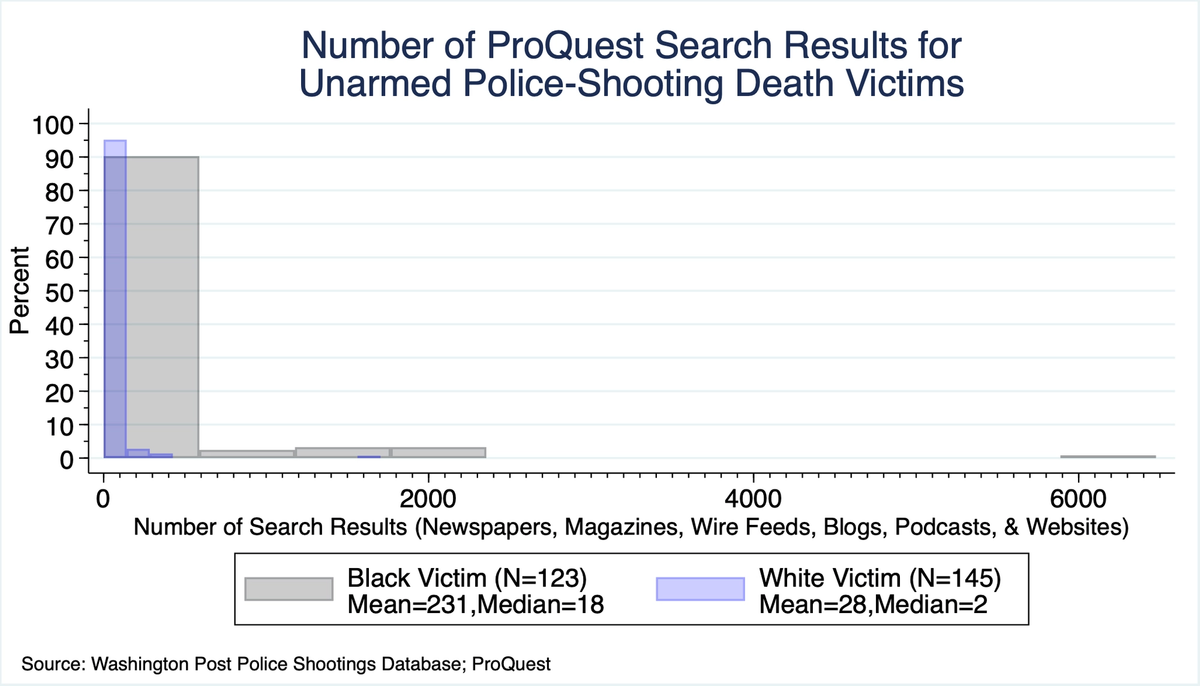
What the data presented here suggests is that editorial decisions made over the past decade at some of the most powerful media outlets in the world about what kind of language to use and what kind of stories merited coverage when it came to race—whatever the intention and level of forethought behind such decisions—has stoked a revival of racial consciousness among their readers. Intentionally or not, by introducing and then constantly repeating a set of key words and concepts, publications like The New York Times have helped normalize among their readership the belief that “color” is the defining attribute of other human beings. For those who adopt this singular focus on race, a racialized view of the world becomes baseline test of political loyalty. It requires adherents to overlook the immense diversity among so-called “People of Color” and “People Not-of-Color” (i.e., whoever is being lumped together as “white” according to the prevailing ideological fashion). In doing so, it has made stereotypes socially acceptable, if not laudable.
The same media institutions that have promoted revanchist identitarianism and the radical transformation of American society along racial lines, could instead have focused their attention and influence on improving the quality of life for all. Working to ensure that Americans of any background aren’t unjustly victimized by the police and have access to quality health care, schools, and affordable housing doesn’t require the promotion of a “race-consciousness” that divides society into “oppressed” and “privileged” color categories. To the contrary, it requires that we de-emphasize these categories and unite in pursuit of common interests. This may not suit the media’s prerogatives, and it may not appeal to activists whose desire for cultural “recognition” trumps their devotion to material progress, but it does offer the potential benefit of improving the lives of ordinary Americans.
Zach Goldberg is a doctoral candidate in Political Science at Georgia State University. His Twitter feed is @ZachG932.